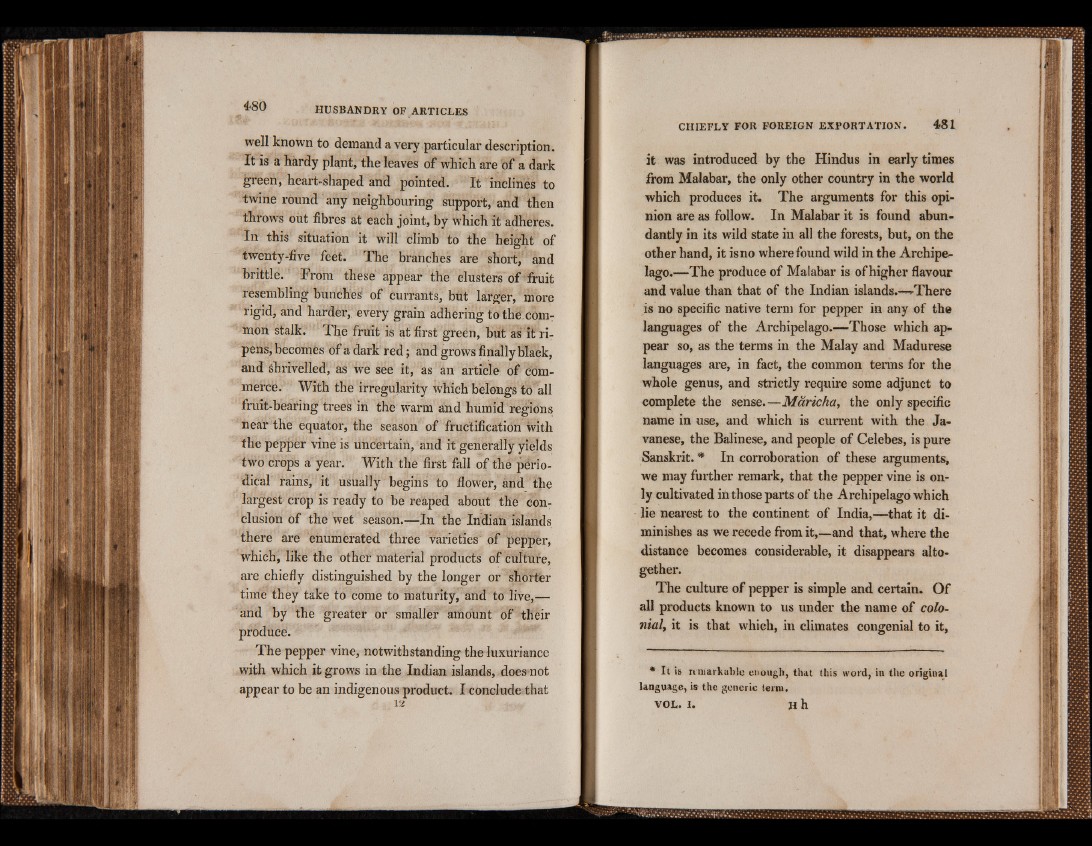
well known to demand a very particular description.
It is a hardy plant, the leaves of which are of a dark
£reen, heart-shaped and pointed. It inclines to
twine round any neighbouring support, and then
throws out fibres at each joint, by which it adheres.
In this situation it will climb to the height of
twenty-five feet. The branches are short, and
brittle. From these appear the clusters of fruit
resembling bunches of currants, but larger, more
rigid, and harder, every grain adhering to the com-;
mon stalk. The fruit is at first green, but as it ripens,
becomes of a dark red; and grows finally black,
and Shrivelled, as we see it, as an article of commerce.
With the irregularity which belongs to all
fruit-bearing trees in the warm and humid regions
near the equator, the season of fructification with
the pepper vine is uncertain, and it generally yields
two crops a year. With the first fall of the periodical
rains, it usually begins to flower, and the
largest crop is ready to be reaped about the conclusion
of the wet season.—In the Indian islands
there are enumerated three Varieties of pepper,
which, like the other material products of culture,
are chiefly distinguished by the longer or shorter
time they take to come to maturity, and to live,—
and by the greater or smaller amount of their
produce.
The pepper vine, notwithstanding the luxuriance
with which it grows in the Indian islands, does not
appear to be an indigenous product. I conclude that
12
it was introduced by the Hindus in early times
from Malabar, the only other country in the world
which produces it. The arguments for this opinion
are as follow. In Malabar it is found abundantly
in its wild state in all the forests, but, on the
other hand, it is no where found wild in the Archipe*-
lago.—The produce of Malabar is of higher flavour
and value than that of the Indian islands.-^-There
is no specific native term for pepper in any of the
languages of the Archipelago.—Those which appear
so, as the terms in the Malay and Madurese
languages are, in fact, the common terms for the
whole genus, and strictly require some adjunct to
complete the sense.—Maricha, the only specific
name in use, and which is current with the Javanese,
the Balinese, and people of Celebes, is pure
Sanskrit. * In corroboration of these arguments,
we may further remark, that the pepper vine is only
cultivated in those parts of the Archipelago which
lie nearest to the continent of India,—that it diminishes
as we recede from it,—and that, where the
distance becomes considerable, it disappears altogether.
The culture of pepper is simple and certain. Of
all products known to us under the name of colonial,
it is that which, in climates congenial to it,
* I t is remarkable enough, that this word, in the original
language, is the generic term.
VOL. I. H h